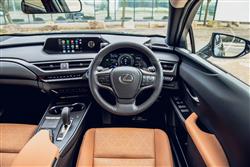MORE THAN A BATTERY OF ISSUES? (some text hidden) --NONE--
By Jonathan Crouch
Introductionword count: 83
The very first fully battery-powered Lexus, the UX 300e, rewards a thoughtful buyer prepared to think a little more laterally. In the segment for fully electric compact-to-mid-sized SUVs, there are cheaper options than this one from the 2020-2023 period, some of which offer greater driving range. But this Lexus has other attributes which might well draw you to it, including admirably few compromises in terms of interior packaging, plus a very high quality feel. Here, we look at the earlier 54.35kWh battery version.
Modelsword count: 3
5dr SUV (EV)
Historyword count: 165
It's rather surprising that until the launch of this car, the UX 300e, we'd never seen a full-electric Lexus. In 2020, after 15 years of market leadership in making electrified hybrid cars, this was the brand's first full-EV. At the time of this model's launch in 2020, we'd yet to see the marque's parent company Toyota launch an EV either, though the UX 300e was actually based on a full-electric version of the Toyota C-HR that then was on sale in China. The UX 300e sat on the same GA-C platform as the ordinary self-charging hybrid UX models. The initial model has a 54.35kWk battery option and its driving range wasn't especially eye-catching, but for the right kind of customer, a number of aspects of this car's ownership proposition might be. The UX 300e sold in this form until Spring 2023, when it was upgraded with a larger 72.8kWh battery and a higher standard of infotainment. It's the earlier smaller-battery model we look at here.
What You Getword count: 522
Lexus is one of those brands who believe that buyers of full-EV models want their cars to look as 'normal' as possible. So the visual changes that differentiate this UX 300e model from its ordinary UX 250h self-charging hybrid showroom stablemate of the period are minimal. The front features a sleeker bumper with smaller air intakes. And a subtly revised version of this model's signature 'spindle'-shaped radiator grille, featuring aerodynamic shutters which automatically open and close depending on the level of battery charge. From the side, lower 'Electric' badges are one of the few giveaways to this model's BEV status; that and the fact that it has two 'filler' flaps, one for a Type 2 charger on the driver's side and one for a fast-charge CHAdeMO plug on the near side. Apart from the bespoke badge, there are no differences over the usual hybrid model at the rear, dominated by an LED tail light 'blade' extending the full width of the tailgate, the lamp section in this case made up of an array of 120 LEDs and tapering in the middle to be just 3mm deep at its narrowest point. Inside, specific UX 300e features are even harder to spot, limited to a bespoke 'drive-by-wire' auto gear selector, branding on the floor mats and badging in the instrument cluster, where you'll also find some EV-specific displays if you look hard enough. Even the central instrument gauge looks much the same as that of the ordinary hybrid model, with its 'charge', 'eco' and 'power' options. Plus in the information display alongside, there are selectable EV options - things like range and your current and average consumption in miles per kWh. From here, you can also select a charging schedule, vary current and the charging limit - and even cool the battery. There's nothing much of note on the 7-inch centre stack screen - just the usual audio, 'phone, apps and climate functions - though it can at least connect through to 'Apple CarPlay'/'Android Auto' smartphone-mirroring - which you'll probably need it to do because navigation wasn't standard unless the original buyer opted for the bigger 10.3-inch 'Lexus Navigation' display, which only came as part of an expensive top 'Takumi' Pack'. Getting in the rear, the door aperture really is rather small - taller folk will risk banging their heads as they enter, due to the re-profiled rear bench - it had to be redesigned to fit the battery underneath. This change didn't compromise rear seat space by very much, but that was pretty tight to start with, exacerbated by the fact that it's difficult to slide your feet beneath the front seats. Let's finish with some good news. The boot is actually bigger than is the case with the UX 250h hybrid version of this car. Lift the tailgate (it's not powered unless you get the top 'Takumi Pack' version) and a 367-litre boot is revealed, 47-litres bigger than normal (loading from deck to the rather flimsy tonneau cover). The conventional 60:40-split flattens to reveal 1,278-litres of capacity, which isn't enormous but will probably be sufficient for the needs of most likely owners.
To see the full road test text contact us on 0330 0020 227
Pictures (high res disabled)

.jpg)
|
.jpg)
|
.jpg)
| |||
.jpg)
|
.jpg)
|
.jpg)
| |||
.jpg)
|
.jpg)
|
.jpg)
| |||
.jpg)
|

|
Scoring (subset of scores)
Category: Hybrid, Plug-in, Electric & Hydrogen
| Performance | |
| Handling | |
| Comfort | |
| Space | |
| Styling, Build, Value, Equipment, Depreciation, Handling, Insurance and Total scores are available with our full data feed. | |



